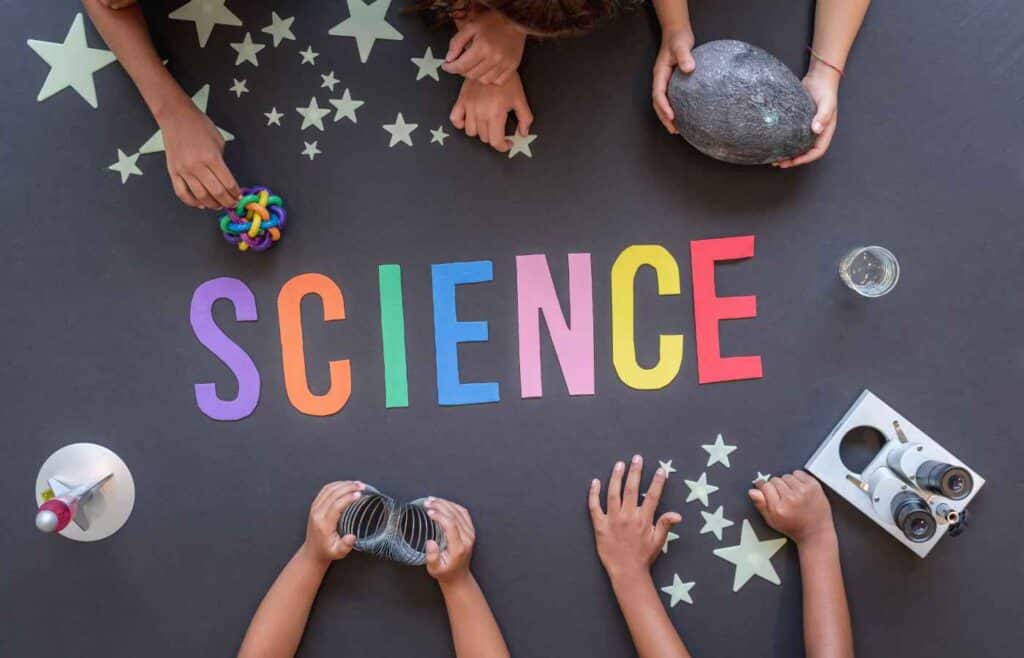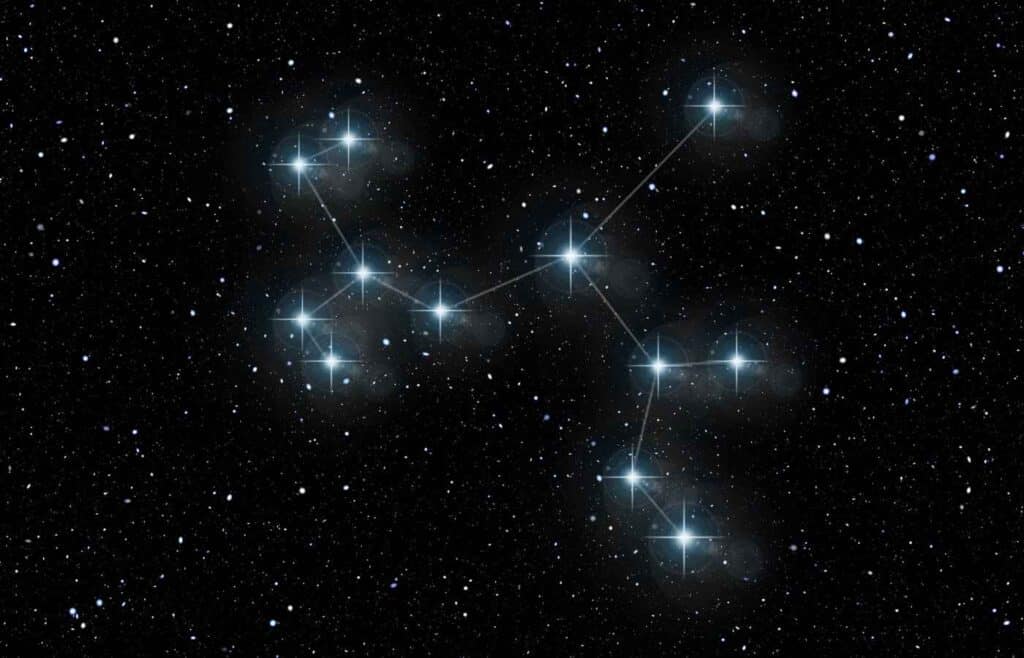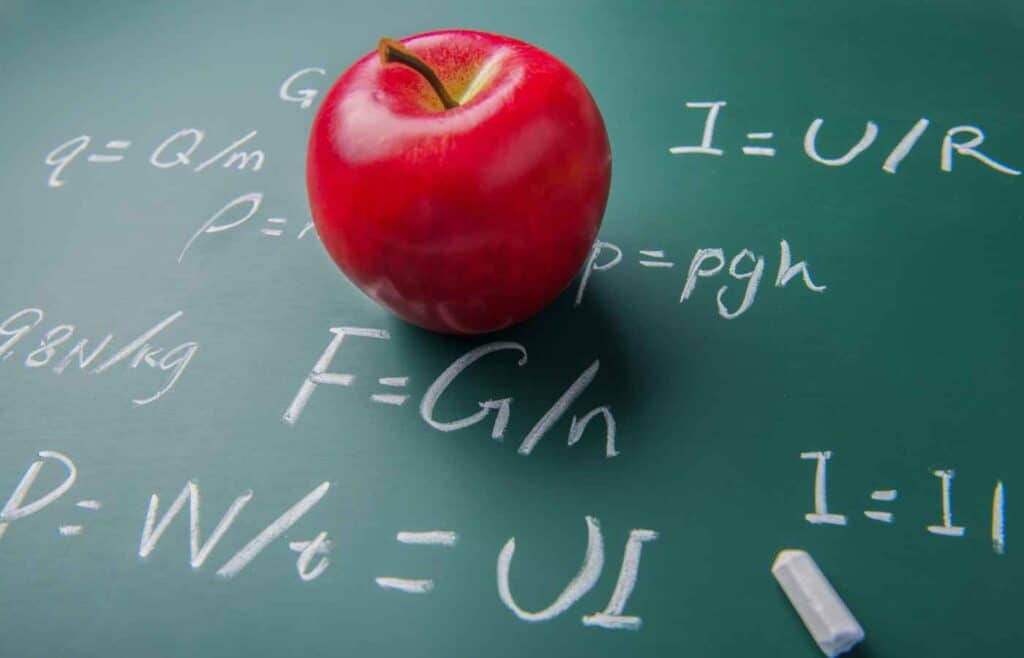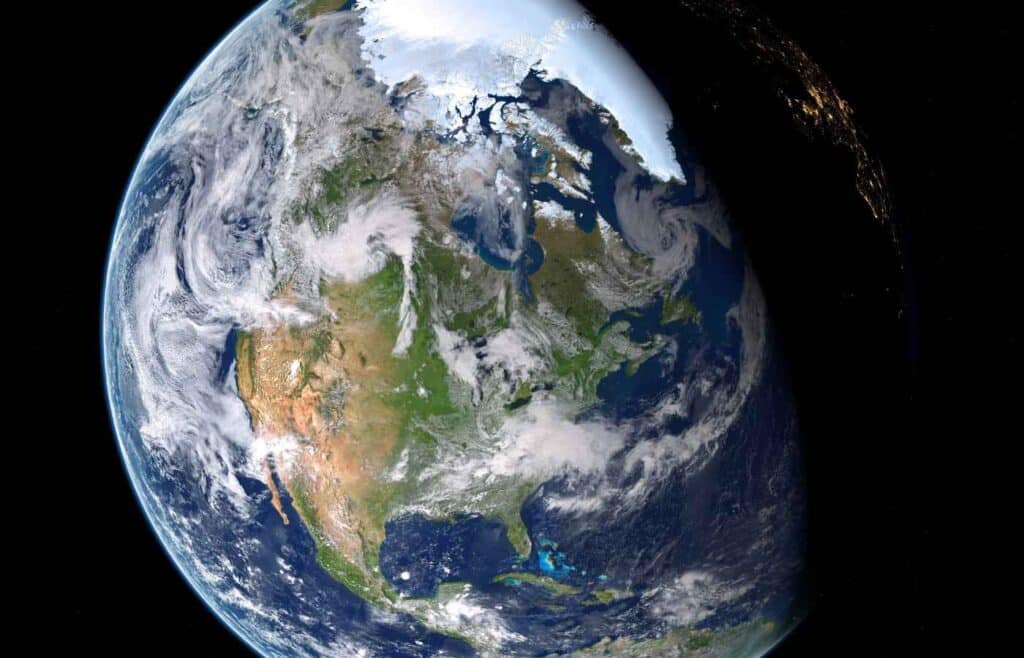Are you looking for a way to pique your child’s curiosity and spark their interest in the world of science?
In this post, we’ve compiled an extensive list of 100 science trivia questions designed specifically for kids.
From fascinating facts about our solar system to the wonders of the animal kingdom, these questions cover a wide range of scientific topics that will entertain and educate young learners.

Science trivia is not only a great way to challenge kids’ knowledge but also a fantastic opportunity to inspire their curiosity about the world around them. Whether you’re planning a family game night, a classroom activity, or just want to spark interesting conversations, these trivia questions are sure to captivate young minds and ignite a passion for science.
In this updated edition for the year 2023, we’ve carefully selected questions that align with the latest scientific discoveries and knowledge.
So, get ready to explore the mysteries of the universe, dive into the depths of biology, uncover the secrets of chemistry, and embark on an adventure of scientific exploration with these engaging trivia questions.
Whether you’re looking to test your own knowledge or challenge your kids, we’re confident that these science trivia questions will provide hours of entertainment and learning. So, without further ado, let’s dive into our collection of 100 science trivia questions for kids and embark on an unforgettable scientific journey!
Related post: 100 Easy Science Experiments For Kids to do at Home
Biology

Biology helps us to understand how living things function, evolve, and interact with their environment. It encompasses everything from the tiniest cells to the complex ecosystems that sustain life on our planet. Let’s dive into some interesting facts and trivia questions about biology and explore the wonders of life together!
- What is the largest organ in the human body? Answer: The skin.
- What is the largest organ inside the human body? Answer: The liver.
- What is the powerhouse of the cell called? Answer: The mitochondria.
- What is the process called when a caterpillar transforms into a butterfly? Answer: Metamorphosis.
- What is the name for the tiny filters in our kidneys that help remove waste from our blood? Answer: Nephrons.
- Which organ in the human body is responsible for pumping blood? Answer: The heart.
- True or false: All living things are made up of cells. Answer: True.
- Which part of the body is responsible for filtering waste from the blood and producing urine Answer: The kidneys.
- What is the pigment that gives plants their green color and helps them with photosynthesis? Answer: Chlorophyll.
- What is the hard outer covering on insects called? Answer: Exoskeleton.
- Which body system is responsible for taking in oxygen and removing carbon dioxide from our bodies? Answer: The respiratory system.
- What is the process called when a plant uses sunlight, water, and carbon dioxide to produce glucose and oxygen? Answer: Photosynthesis.
- These answers provide key insights into the topics covered by the biology trivia questions, allowing children to expand their understanding of the biological world.
- What is the process called when a tadpole transforms into a frog? Answer: Metamorphosis.
- What is the largest mammal on Earth? Answer: The blue whale.
- What is the largest land animal on Earth? The African elephant.
- What is the substance that gives human skin, hair, and nails their color? Answer: Melanin.
- True or false: Birds are the only animals that can fly. Answer: False. Bats can also fly.
- Which sense do taste buds help us with? Answer: Taste.
- What is the name of the tiny, thread-like structures that carry genetic information in cells? Answer: DNA (Deoxyribonucleic Acid).
- True or false: All living things need water to survive. Answer: True.
- Which animal is known for its ability to regrow its tail? Answer: A lizard (or specifically, some species of lizards).
- What is the process called when plants release oxygen into the air? Answer: Photosynthesis.
- What is the name of the process by which plants make food using sunlight, water, and carbon dioxide? Answer: Photosynthesis.
- Which type of animal lays eggs: mammals or reptiles? Answer: Reptiles.
- True or false: The human brain weighs more than the human heart. Answer: False. The human heart weighs more than the brain.
- What is the green pigment found in the leaves of plants that helps with photosynthesis? Answer: Chlorophyll.
- What is the process called when a plant loses water through its leaves? Answer: Transpiration.
- On average, how many bones are in the adult human body? Answer: There are 206 bones in the adult human body.
- What is the heaviest organ in the human body by weight? Answer: The liver
Chemistry

Chemistry is a branch of science that helps us understand the properties, composition, and behavior of substances. From the periodic table to compound and reactions, it is an exciting field that allows us to unlock the secrets of the universe, from the air we breathe to the materials we use every day. Here are some fun trivia questions about chemistry for kids:
- What is the symbol for the element hydrogen? Answer: H.
- What is the chemical symbol for oxygen? Answer: O.
- What is the smallest unit of matter called? Answer: An atom.
- What is the process called when a solid turns into a liquid? Answer: Melting.
- What is the process called when a liquid turns into a gas? Answer: Evaporation.
- True or false: Water is a liquid at room temperature. Answer: True.
- What is the chemical symbol for carbon? Answer: C.
- What is the formula for water? Answer: H2O.
- What is the chemical symbol for gold? Answer: Au.
- What is the process called when a gas turns into a liquid? Answer: Condensation.
- True or false: Salt dissolves in water. Answer: True.
- What is the chemical symbol for iron? Answer: Fe.
- What is the formula for carbon dioxide? Answer: CO2.
- What is the process called when a liquid turns into a solid? Answer: Freezing.
- What is the chemical symbol for silver?A nswer: Ag.
- What is the formula for table salt (sodium chloride)? Answer: NaCl.
- True or false: Oxygen is necessary for fire to burn. Answer: True.
- What is the chemical symbol for helium? Answer: He.
- What is the formula for methane? Answer: CH4.
- What is the process called when a gas turns directly into a solid? Answer: Deposition.
- True or false: Carbon dioxide is produced when we exhale. Answer: True.
- What is the chemical symbol for nitrogen? Answer: N.
- What is the formula for sulfuric acid? Answer: H2SO4.
- What is the process called when a solid turns directly into a gas without becoming a liquid first? Answer: Sublimation.
- True or false: Water is an example of a compound. Answer: True.
- What is the most abundant gas? Nitrogen (chemical symbol: N2). It makes up about 78% of the air we breathe.
Astronomy

Embark on a journey through the stars, planets, and galaxies as we unveil captivating facts about our universe. Get ready to witness celestial wonders, discover distant worlds, and ignite your curiosity about the mysteries of space. Let’s dive into the realm of astronomy and unlock the secrets of the cosmos together.
- What is the closest celestial body to Earth? Answer: The Moon.
- Which planet is known as the “Red Planet”? Answer: Mars.
- What is the largest planet in our solar system? Answer: Jupiter.
- True or false: The Sun is a star. Answer: True.
- What is the name of the galaxy that contains our solar system? Answer: The Milky Way.
- What is the name of the largest moon of Saturn? Answer: Titan.
- True or false: The Sun is the largest object in our solar system. Answer: True.
- What is the name of the first man-made object to reach space? Answer: Sputnik 1.
- Which planet is known for its beautiful ring system? Answer: Saturn.
- How many planets are there in our solar system? Answer: Eight.
- True or false: The Earth is the only planet in our solar system with liquid water. Answer: True.
- What is the name of the closest star to Earth (other than the Sun)? Answer: Proxima Centauri.
- Which planet has the most moons? Answer: Jupiter.
- True or false: Pluto is considered a planet. Answer: False. Pluto is now classified as a dwarf planet.
- What is the name of the galaxy group that includes the Milky Way? Answer: The Local Group.
- What is the name of the largest volcano in our solar system, located on Mars? Answer: Olympus Mons.
- True or false: The Moon has its own atmosphere. Answer: False. The Moon has virtually no atmosphere.
- Which planet is known for its iconic Great Red Spot? Answer: Jupiter.
- What is the name of the phenomenon where the Moon partially or completely covers the Sun? Answer: Solar eclipse.
- True or false: The North Star (Polaris) is the brightest star in the night sky. Answer: False. The North Star is not the brightest star; it is relatively bright due to its position.
- What is the name of the largest known star in the universe? Answer: UY Scuti.
- Which planet has the hottest surface temperature in our solar system? Answer: Venus.
- True or false: All stars in the night sky are roughly the same size. Answer: False. Stars come in different sizes.
- What is the name of the phenomenon where a meteoroid enters Earth’s atmosphere and burns up?Answer: Meteor (shooting star).
- How long does it take for the Earth to complete one orbit around the Sun? Answer: One year, or approximately 365 days.
Physics

Let’s unravel the laws that govern motion, energy, and the behavior of matter. In this section of “100 Science Trivia Questions For Kids (2023),” we delve into the realm of physics, exploring concepts that shape our understanding of the universe. Get ready to test your knowledge and discover the wonders of physics!
- What is the force that pulls objects towards the center of the Earth? Answer: Gravity.
- What is the unit of measurement for force? Answer: Newton.
- True or false: Light travels faster than sound. Answer: True.
- What is the law of motion that states “for every action, there is an equal and opposite reaction”? Answer: Newton’s third law of motion.
- What is the unit of measurement for speed? Answer: Meters per second (m/s).
- True or false: Sound needs a medium, like air or water, to travel.Answer: True.
- What is the force that resists motion when two objects rub against each other? Answer: Friction.
- What is the unit of measurement for energy? Answer: Joule.
- True or false: A magnet has a north pole and a south pole. Answer: True.
- What is the law of physics that states “an object at rest stays at rest, and an object in motion stays in motion unless acted upon by an external force”? Answer: Newton’s first law of motion (also known as the law of inertia).
- What is the unit of measurement for distance? Answer: Meter.
- True or false: Energy can neither be created nor destroyed; it can only be transformed from one form to another. Answer: True (according to the law of conservation of energy).
- What is the force that opposes the motion of an object through a fluid, such as air or water? Answer: Drag.
- What is the unit of measurement for time? Answer: Second.
- True or false: An object with a higher temperature will transfer heat to an object with a lower temperature. Answer: True.
- What is the force that holds atoms and molecules together in a solid? Answer: Strong nuclear force.
- What is the unit of measurement for weight? Answer: Newton.
- True or false: An object with a larger mass will have a greater gravitational pull. Answer: True.
- What is the law of physics that states “the rate of change of momentum of an object is directly proportional to the force applied and occurs in the direction in which the force is applied”?Answer: Newton’s second law of motion.
- What is the unit of measurement for power? Answer: Watt.
- True or false: All objects, regardless of their mass, fall at the same rate in a vacuum. Answer: True (in the absence of air resistance).
- What is the force that pushes objects apart when they are in close proximity? Answer: Repulsion.
- What is the unit of measurement for electric current? Answer: Ampere.
- True or false: The Earth rotates on its axis, causing day and night. Answer: True.
- Which famous scientist formulated the laws of motion and universal gravitation? Answer: Isaac Newton.
These physics trivia questions cover a range of fundamental concepts, principles, and notable figures in the field of physics. They are designed to engage young minds and inspire curiosity about the laws that govern the physical world.
Earth Sciences

Now, let’s explore the wonders of our planet, from its geological formations to its dynamic weather patterns. In this section of “100 Science Trivia Questions For Kids (2023),” we delve into the fascinating world of Earth science, uncovering the secrets of our home. Get ready to test your knowledge and discover the marvels of the natural world!
- What is the outermost layer of the Earth called? Answer: The crust.
- True or false: Earth is the only known planet to support life. Answer: True.
- What is the process of changing solid ice into liquid water called? Answer: Melting.
- What is the study of Earth’s atmosphere and weather called? Answer: Meteorology.
- True or false: Earth is mostly covered by water. Answer: True.
- What is the name of the largest ocean on Earth? Answer: The Pacific Ocean.
- What is the process of breaking down rocks into smaller pieces called? Answer: Weathering.
- True or false: Volcanoes are formed by the eruption of molten rock from Earth’s interior. Answer: True.
- What is the study of earthquakes called? Answer: Seismology.
- What is the name of the layer of the atmosphere where weather occurs? Answer: The troposphere.
- True or false: Earth’s magnetic field is generated by its solid iron core .Answer: True.
- What is the force that pulls objects towards the center of the Earth called? Answer: Gravity.
- What is the study of fossils and ancient life forms called? Answer: Paleontology.
- True or false: Earth’s continents were once connected in a supercontinent called Pangaea. Answer: True.
- What is the process of changing liquid water into vapor called? Answer: Evaporation.
- What is the study of Earth’s rocks and minerals called? Answer: Geology.
- True or false: The Great Barrier Reef is the largest coral reef system in the world. Answer: True.
- What is the name of the layer of the atmosphere that contains the ozone layer? Answer: The stratosphere.
- What is the process of moving weathered materials from one place to another called? Answer: Erosion.
- True or false: The Grand Canyon in the United States was formed by the erosion of the Colorado River. Answer: True.
- What is the study of Earth’s landforms, such as mountains and valleys, called? Answer: Geomorphology.
- True or false: Earth’s seasons are caused by its elliptical orbit around the Sun. Answer: False. Earth’s seasons are caused by its axial tilt.
- What is the name of the layer of the atmosphere where auroras occur? Answer: The thermosphere.
- True or false: The Sahara Desert is the largest hot desert in the world. Answer: True.
- What is the study of Earth’s oceans called? Answer: Oceanography.
These Earth science trivia questions cover a variety of topics, including geology, weather, oceans, and more. They aim to ignite curiosity and encourage young learners to explore the wonders of our planet.
Misc.

Want more? Here are some general science trivia questions for kids about various topics:
- What prestigious international award is given annually for achievements in various fields, including physics, chemistry, and medicine? Answer: The Nobel Prize.
- Who is the famous inventor known for his contributions to the development of the practical light bulb and phonograph? Answer: Thomas Edison.
- What substance, when in its liquid state, is refreshing and commonly used to cool down or quench thirst? Answer: Water.
- Who is credited with inventing the telephone?Answer: Alexander Graham Bell.
- What animal holds the title for being the fastest land animal?Answer: The cheetah.
- What is the term used to describe a natural satellite that orbits around a planet? Answer: Moon.
- What is the boiling point of water?Answer: 100 degrees Celsius or 212 degrees Fahrenheit.
- What part of the human body is responsible for pumping blood throughout the body?Answer: The heart.
- What term is used to describe the vast expanse beyond Earth’s atmosphere that includes stars, planets, and galaxies?Answer: Outer space.
- Who is the scientist known for formulating the theory of evolution by natural selection?Answer: Charles Darwin.
- Who was the first person to set foot on the moon? Answer: Neil Armstrong.
- What is the tallest mountain on Earth? Answer: The tallest mountain on Earth is Mount Everest. It is located in the Himalayas on the border of Nepal and Tibet (China). Mount Everest stands at an impressive height of 8,848.86 meters (29,031.7 feet) above sea level.
- What famous comet visits our solar system approximately every 76 years? Answer: Halley’s Comet.
- Who was the first woman to win two Nobel Prizes in different scientific fields? Answer: Marie Curie.
- Can you name the order of the planets in our solar system, starting from the one closest to the Sun? Answer: Mercury, Venus, Earth, Mars, Jupiter, Saturn, Uranus, Neptune.
- What is the phenomenon where hot water freezes faster than cold water? Answer: The Mpemba Effect.
- What is the nearest planet to earth? Venus.
- What is the average body temperature of a human? The average body temperature of a human is approximately 37 degrees Celsius or 98.6 degrees Fahrenheit.
- What is a region in space where gravity is so strong that nothing, not even light, can escape is gravitational pull? Answer: a black hole
- What handheld device is used to detect ionizing radiation? A geiger counter.
- What is the biggest planet in the solar sytem? The biggest planet in our solar system is Jupiter. It is a gas giant with a diameter of about 143,000 kilometers (88,800 miles), which makes it more than 11 times larger than Earth in terms of diameter.
- What are the enormous, rigid pieces of Earth’s crust and upper mantle that fit together like a jigsaw puzzle and move over the semi-fluid layer below them? Answer: Tectonic plates.
- What is the primary reason why climbing Mount Everest is physically challenging? Answer: The reduced oxygen levels at high altitudes.
- What is the smallest bone in the human body? The stirrup bone, also known as the stapes. It is one of the three tiny bones located in the middle ear, collectively known as the ossicles.
- Which renowned scientist is famous for developing the theory of relativity and is often associated with the equation E=mc²? Answer: Albert Einstein.
We’ve covered a wide range of topics, including animals, plants, space, chemistry, biology, physics, and more. From the solar system to the boiling point of water, from the discovery of penicillin to the largest land animal, we’ve journeyed through an exciting list of science trivia questions.
I hope this extensive list of science trivia questions brought you lots of fun and learning! Enjoy the journey of discovery, expand your understanding, and embrace the wonders of science in all its fascinating glory.
Related Posts:
100 Middle School Trivia Questions
250 Best Jeopardy Questions For Kids
100 Easy Science Experiments for Kids to do at Home
10 Best Cold Weather Science Experiments For Kids
250 Never Have I Ever Questions for Kids








